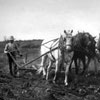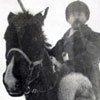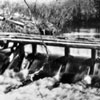Agriculture
 As with any other rural settlement in the western plains, agriculture was paramount to the survival of the early pioneer family. In central Alberta clearing the land was a strenuous task in the area's cool, wet climate. Further south however, in the warmer, drier climate of southern Alberta, lack of moisture and soil erosion were among the chief concerns for pioneer families. Cooperation with other nearby families was essential in producing a successful crop. In fact, households and gardens were operated individually but the fields were managed collectively. Grain crops were difficult to grow in the virgin lands as the fields required machinery and draft animals, luxuries which Estonian farmers could simply not afford. In the first few years, vegetables such as potatoes, carrots, cabbage, onions, and turnips were most common. As the soil improved over the years, the settlers raised rye, barley, and oats and established dairy herds.
As with any other rural settlement in the western plains, agriculture was paramount to the survival of the early pioneer family. In central Alberta clearing the land was a strenuous task in the area's cool, wet climate. Further south however, in the warmer, drier climate of southern Alberta, lack of moisture and soil erosion were among the chief concerns for pioneer families. Cooperation with other nearby families was essential in producing a successful crop. In fact, households and gardens were operated individually but the fields were managed collectively. Grain crops were difficult to grow in the virgin lands as the fields required machinery and draft animals, luxuries which Estonian farmers could simply not afford. In the first few years, vegetables such as potatoes, carrots, cabbage, onions, and turnips were most common. As the soil improved over the years, the settlers raised rye, barley, and oats and established dairy herds.
 Central Alberta's topography also provided ideal hunting and fishing locations. Nearby streams and dense forests for example, provided fish and game. Hunting and fishing were important supplementary activities to farming and emphasized the ruggedness of the early settlers' lifestyle. In the first few years of settlement, finding employment in the cities or nearby towns was necessary since most Estonian settlers had little cash.
Central Alberta's topography also provided ideal hunting and fishing locations. Nearby streams and dense forests for example, provided fish and game. Hunting and fishing were important supplementary activities to farming and emphasized the ruggedness of the early settlers' lifestyle. In the first few years of settlement, finding employment in the cities or nearby towns was necessary since most Estonian settlers had little cash.
 Working on the Canadian Pacific Railway for 10 hours per day, for instance, could generate $1.33 for the average worker. However, as agricultural technology advanced and the soil improved, Estonians often found other ways of generating profit. Between 1908 and 1910, grist mills, windmills, and dams were built to complement the Estonian agricultural lifestyle.
Working on the Canadian Pacific Railway for 10 hours per day, for instance, could generate $1.33 for the average worker. However, as agricultural technology advanced and the soil improved, Estonians often found other ways of generating profit. Between 1908 and 1910, grist mills, windmills, and dams were built to complement the Estonian agricultural lifestyle.








